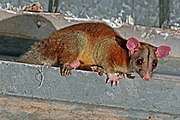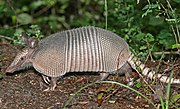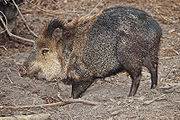List of mammals of Central America
The rest of North America is mostly subtropical or temperate, belongs to the Nearctic realm, and has far fewer species of South American origin.The formation of this land bridge through volcanic activity three million years ago precipitated the Great American Interchange, an important biogeographical event.[1] The mountains running down the spine of Central America have also contributed to biodiversity by creating montane habitats, including cloud forests and grasslands, and by separating species from the lowlands along the Pacific and Caribbean coasts.The effects of modern human activities on climate and ecosystem integrity pose a further threat to Central America's fauna.This list consists of those mammal species found from the Isthmus of Tehuantepec to the northwestern border of Colombia, a region including the Mexican states of Chiapas, Tabasco, Campeche, Yucatán and Quintana Roo, and the nations of Belize, Guatemala, El Salvador, Honduras, Nicaragua, Costa Rica and Panama.They are small to medium-sized marsupials, about the size of a large house cat, with a long snout and prehensile tail.Their much larger relatives, the pampatheres and glyptodonts, once lived in North and South America but became extinct following the appearance of humans.Numerous ground sloths, some of which reached the size of elephants, were once present in both North and South America, as well as on the Antilles, but all went extinct following the arrival of humans.Central American monkeys are recent immigrants from South America, where their ancestors arrived after rafting over from Africa 25 million years ago.Shrews and solenodons closely resemble mice, hedgehogs carry spines, while moles are stout-bodied burrowers.While native equids once lived in the region, having evolved in North America over a period of 50 million years, they died out around the time of the first arrival of humans, along with at least one ungulate of South American origin, the notoungulate, Mixotoxodon.They are the mammals most fully adapted to aquatic life with a spindle-shaped nearly hairless body, protected by a thick layer of blubber, and forelimbs and tail modified to provide propulsion underwater.





Central AmericaBelizeCosta RicaEl SalvadorGuatemalaHondurasNicaraguaPanamaCentral American SpanishMesoamericaEthnic groupsAnglican ChurchBahá'í FaithBuddhismRoman CatholicismCentral American GamesCentral American and Caribbean GamesFootball UnionBioregionDeforestationDry forestsMontane forestsMountain peaksPine–oak forestsHistoryCentral American crisisMexican ruleFederal RepublicHeads of stateGreater RepublicMaya civilizationCentral HighlandsCitiesIslandsMountainsExtreme summitsUltra-prominent summitsRiversVolcanoesMiddle AmericaMiddle America TrenchIntegration SystemParliamentList of busiest airportsList of largest airlinesRail transportIndex of articlesAmericas (terminology)Central Time ZoneLatin AmericaNorth AmericaAmericastropicalNeotropical realmSouth AmericansubtropicaltemperateNearctic realmGreat American InterchangebiogeographicalbiodiverseMesoamericanbiodiversity hotspotmontanecloud forestsgrasslandslowlandsPacificCaribbeanQuaternary extinction eventPaleoindiansmegafaunaclimateecosystemfurther threatmammalIsthmus of TehuantepecColombiaMexican statesChiapasTabascoCampecheYucatánQuintana Rooopossumsxenarthransmonkeyscaviomorph rodentsDomestic speciesintroduced speciesInternational Union for Conservation of NatureExtinctExtinct in the wildCritically endangeredEndangeredVulnerableNear threatenedLeast concernData deficientNot evaluatedTheriaDerby's woolly opossumWater opossumVirginia opossumCommon opossumRobinson's mouse opossumGray four-eyed opossumMetatheriaMarsupialsinfraclasspouchedGondwananAmeridelphiaDidelphimorphiaWestern HemisphereCretaceousPaleoceneprehensile tailDidelphidaeCaluromyinaeCaluromysDidelphinaeChironectesDidelphisMarmosaIsthmian mouse opossum








































































